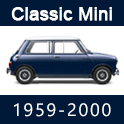Classic Mini Quick View Production Timeline (English)
08/59 Minis introduced as the Austin Seven and the Morris Mini Minor
01/60 Van introduced
09/60 Estate models (with wood) introduced Morris Mini-Minor Traveller and Austin Seven Countryman
01/61 Pickup introduced
09/61 Super introduced
10/61 997cc Cooper introduced
10/61 Riley Elf and Wolseley Hornet introduced
01/62 Austin Seven name changed to Austin Mini
10/62 Super discontinued
10/62 Estate (without wood) introduced as option
11/62 Mk II Elf and Hornet introduced w/998cc engine and dual leading shoe brakes03/63 1071cc Cooper S introduced
01/64 997cc Cooper discontinued
01/64 998cc Cooper introduced
03/64 1275cc Cooper S and 970cc Cooper S introduced
08/64 1071cc Cooper S discontinued
08/64 Moke introduced
09/64 Hydrolastic suspension introduced on all saloon models
09/64 Dual leading shoe brakes introduced to the rest of the Mini line, not just the Elf and Hornet
01/65 970cc Cooper S discontinued
05/65 Automatic transmission introduced
01/66 Cooper S fitted with dual tanks and oil cooler as standard
10/66 Mk III Elf and Hornet introduced with roll up windows, air vents and an optional heated rear window.
10/67 Mk II line introduced w/square tail lights, changed grille and larger rear widow.
10/67 998cc engine (non Cooper) introduced earlier on the Elf and Hornet now optional on other models.
10/67 Morris Mini-Minor name changed to Morris Mini.
09/68 Four synchro gearbox now in all models.
10/68 Moke discontinued (English version)
08/69 Riley Elf and Wolseley Hornet discontinued.
09/69 Traveller, Countryman and 998cc Cooper discontinued
09/69 End of hydrolastic suspension; except for Cooper S and 1275GT
09/69 Austin, Morris, Riley and Wolseley names dropped. Marque name becomes Mini
10/69 Mk III introduced w/windup windows and concealed door hinges
10/69 Clubman (saloon and estate w 998cc engine) and 1275GT (with 1275cc – non-S -- engine) introduced
02/70 Mk II Cooper S discontinued
03/70 Mk III Cooper S introduced
07/71 Mk III Cooper S discontinued
07/71 Hydrolastic discontinued on Cooper S and 1275GT
01/73 Alternator replaces generator on all models
01/73 Rod change gearbox introduced
04/73 Inboard CV (“pot”) joints introduced
05/74 HS4 as standard on all models
06/74 8.4” brakes, 12” wheels and 7.5 gal (imp.) tank on the 1275GT
10/75 1098cc engine replaced 998cc in Clubman saloon and estate (automatics continued as 998cc)
05/76 Mk IV introduced w/rubber mounted front subframe, larger pedals, and twin column stalks.
08/77 Reversing light incorporated in back up lights
??/80 7.5 imperial gallon tank introduced is saloon
08/80 Clubman and 1275GT discontinued
09/80 848cc engine discontinued in saloons
09/80 A+ 998cc engine
??/80 Verto clutch
10/80 Clubman estate name changed to HL Estate (w/998cc engine)
11/80 848cc engine discontinued as option in pickup. Available in van until end of production
09/82 HL Estate discontinued
12/82 Pickup and Van discontinued
06/84 8.4” brakes and 12” wheels on Mini 25 only
??/84 Softer rubber cones/springs introduced
10/84 Mk V w/8.4” brakes and 12” wheels as standard introduced
10/88 Servo standard
07/90 Rover Cooper RSP w/1275 introduced as a limited editon
09/90 Rover Cooper mainstream model introduced
03/91 Rover Cooper S option available w/factory approved conversion kit
06/91 Lamm Cabriolet introduced. 75 built. Had 13” wheels standard.
10/91 Mk VI Cooper models introduced w/SPi and catalytic converter.
03/92 Rover Cooper Si option available w/factory approved conversion kit
04/92 998cc engine discontinued
05/92 Mk VI mainstream Mini introduced w/1275 carb engine and catalyst
07/93 Rover Cabriolet introduced
08/94 Mainstream Minis (non-Cooper) go from carb to SPi
08/96 SPi, Rover Cabriolet and Automatic transmission discontinued
10/96 MPi, Sports Pack, John Cooper S and S works introduced
10/00 Mini production stops
Notes:
• Dates apply to English production for the home market. Can be applied to English production for export in most cases. Less likely to apply to Minis manufactured in other countries.
• Dates may vary depending upon different sources. Dates are often quoted as a mixture of the beginning of production, the introduction dates at car shows, the beginning date of marketing and/or the dates the cars were first available for the public to buy.
• Mechanical changes may have started at a certain date, but been phased in over time for different models; such as, the 4-syncro gearbox.









